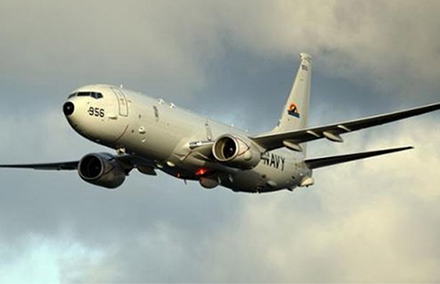
The US Poseidon spy plane.
Sino-US tensions increase amid Poseidon spy plane deployment to Singapore.
On 7 December 2015, the US and Singapore signed the enhanced defense cooperation agreement.
Under it, both countries pledged to work together on five key areas: military, strategic, policy, technology and non-traditional security challenges such as cybersecurity to counterterrorism. Of significance is the announcement that Singapore has allowed the US to operate a fleet of Poseidon spy planes from its bases.
This move comes at a time of heightened tensions in the South China Sea. For months now, the US has criticised China’s building of artificial islands, calling it ‘out of step with international rules’ — especially when it came to light that it has been steadily deploying defensive structures, air defense systems and paving airstrips in the islands.
Despite Beijing’s contention that the islands are for civilian purposes, the US views this build-up as China’s attempt at strengthening existing power projection capabilities.
In recent years, the Obama Administration has stepped up the US’ security presence in Singapore, deploying two littoral combat ships to the city-state. Clearly, the Poseidon deployment is part of a bigger strategy by the US to contain China by not allowing it to fundamentally shift the balance of power in the Asia-Pacific region.
China expressed discontent with the deployment, calling it an act of ‘militarisation’ by the US and maintained that the situation in the South China Sea is peaceful and stable. China also argued that the deployment ‘goes against the common and long-term interests of countries in the region.’
This is ironic since countries in the region – namely Japan and Southeast Asia nations – have grown increasingly nervous about China’s unilateral posturing and disregard for international law in making its maritime claims.
For its part, Singapore faces a tricky situation of appeasing both the US and China.
China is Singapore’s largest trading partner and Singapore has been a significant investor in China for many years. While China has not placed any blame on Singapore for the deployment, the city-state was equally careful to position the agreement with the US under the ambit of ‘relationship building’ and ‘humanitarian and disaster relief’.
Singapore relies on the US for the sale of arms, and access to its bases for the conduct of training and joint-exercise operations for its servicemen. The Poseidon deployment also assuages Singapore’s concerns over the unfolding situation in the South China Sea.
The disquieting fact is that the disputed waters in the South China Sea are a flashpoint for an all out war between the US and China. Although there have not been any skirmishes, both sides have resorted to employing maneuvers to see which side blinks first.
In May last year, a P8 Poseidon flew over the contested waters in the South China Sea only to have the Chinese Navy issue numerous warnings for the American aircraft to leave the area.
In October, the USS Lassen, a destroyer sailed within 12 nautical miles of one of the islands claimed by China in the Spratly Islands. The Chinese promptly issued a warning to the Americans, stating that a minor incident could escalate into full-scale conflict.
It would serve us well to be reminded that in 2001, a EP-3 Aries spy plane collided with a Chinese fighter jet, 50 miles southeast of China’s Hainan Island causing a international dispute between the two countries. The Chinese fighter crashed into the sea, killing the pilot, while the American plane was forced to land in Hainan where 24 of its crew were detained and interrogated before being released. (For more on this see the CRS report to Congress.)
Now as Washington strengthens its resolve and Beijing refuses to back down, the real question is how far either side is going to go before things really get out of hand.
Patrick Sagaram lives in Singapore and works as a teacher.
 Facebook
Facebook  Twitter
Twitter  Soundcloud
Soundcloud  Youtube
Youtube  Rss
Rss